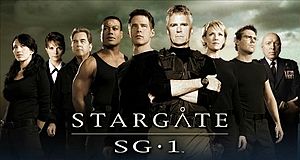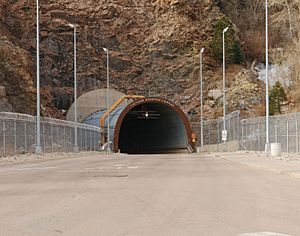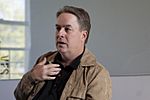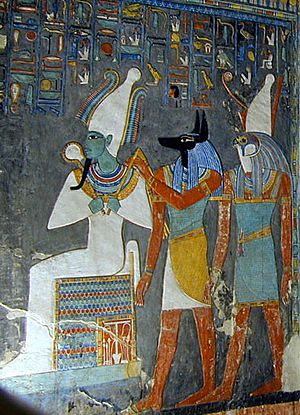Stargate SG-1 facts for kids
Quick facts for kids Stargate SG-1 |
|
|---|---|
 |
|
| Genre | Action/adventure Science fiction |
| Created by |
|
| Based on | Stargate by Roland Emmerich Dean Devlin |
| Starring |
|
| Theme music composer | Joel Goldsmith |
| Composer(s) | Joel Goldsmith |
| Country of origin |
|
| Original language(s) | English |
| No. of seasons | 10 |
| No. of episodes | 214 + 2 DVD films (list of episodes) |
| Production | |
| Executive producer(s) |
|
| Running time | 44 minutes |
| Production company(s) | MGM Television Double Secret Productions Gekko Film Corp. (1997–2005) (seasons 1–8) Sony Pictures Television (2005–2006) (season 9) Showtime Networks (1997–2002) (seasons 1–5) Sci-Fi Originals (2002–2007) (seasons 6–10) |
| Release | |
| Original network | |
| Original release | July 27, 1997 – March 13, 2007 |
| Chronology | |
| Related shows |
|
Stargate SG-1 (often called SG-1) is a cool military science fiction adventure TV show. It's part of the Stargate story world. The show was made by Brad Wright and Jonathan Glassner. It's based on the 1994 movie Stargate. The series was filmed in Vancouver, British Columbia, Canada. It first aired on Showtime in 1997. Later, it moved to the Sci Fi Channel in 2002. The very last episode came out in 2007.
The story of Stargate SG-1 starts about a year after the movie. The United States government finds out about an old alien device. This device is called the Stargate. It can open a portal to many other planets and even space! SG-1 is a special team from the United States Air Force. They are one of about 20 teams from Earth. Their job is to explore the galaxy and protect Earth. They fight alien threats like the Goa'uld, the Replicators, and the Ori. The show uses ideas from Egyptian, Greek, and Norse mythology. It also uses the legend of King Arthur.
Stargate SG-1 was very popular, especially in Europe and Australia. It won many awards during its ten years on TV. It also led to other Stargate shows. These include the cartoon Stargate Infinity and live-action shows like Stargate Atlantis and Stargate Universe. There were also movies made for DVD, like Stargate: The Ark of Truth and Stargate: Continuum. You could also find games, toys, books, and audio stories based on Stargate SG-1.
Contents
Exploring the Galaxy: What is Stargate SG-1 About?
The story of Stargate SG-1 begins one year after the first movie. It follows the adventures of SG-1, a military team from Earth. SG-1 and other teams travel to faraway planets. They use the alien portal called a Stargate. This Stargate is kept in a secret United States Air Force base. The base is called Stargate Command (SGC). It's hidden deep inside the Cheyenne Mountain Complex in Colorado Springs, Colorado.
For the first eight seasons, the SG teams explore the galaxy. They look for alien technology and friends. Their main goal is to protect Earth from the Goa'uld. The Goa'uld are snake-like aliens. They take over humans as hosts. The show explains that the Goa'uld brought human slaves from Earth to other planets long ago. Now, they pretend to be old gods from Earth's myths, especially Ancient Egypt.
SG-1 later learns about the Ancients. These are very old, human-like beings. They built the Stargate network millions of years ago. Then, they moved to a higher level of existence. They promised not to get involved in other species' lives. But the Ori are different. They are part of the same race as the Ancients. The Ori use their powers to control others with their religion. They become the main bad guys in Season 9 and Season 10.
Fighting the Goa'uld: Early Threats
In the first episode, "Children of the Gods", a Goa'uld leader named Apophis attacks Earth. He uses the Stargate to kidnap an airman. This makes the SGC base active again. They learn the Stargate is part of a huge network connecting many planets. SG teams are formed to defend Earth. The Goa'uld have pyramid warships and huge armies of Jaffa. Jaffa are their slaves and soldiers.
Earth's main team, SG-1, includes Teal'c. He is Apophis's top Jaffa soldier who switched sides. SG-1 makes friends with other groups in the galaxy. These include the friendly Tok'ra, the smart Tollan, the peaceful Nox, and the helpful Asgard. They also find some powerful Ancients.
A new alien threat appears in Season 3. These are smart machines called Replicators. Also, a secret Earth group called the NID tries to take control of the Stargate. Even after Apophis dies in Season 5, the Goa'uld Empire stays a big enemy until Season 8. The last Goa'uld leader, Ba'al, is defeated in the movie Stargate: Continuum.
New Enemies: Anubis and the Ori
After Apophis is defeated, a powerful Goa'uld named Anubis becomes the main villain. He knows a lot about the Ancients and their technology. While Earth builds its first spaceship, the Prometheus, Anubis creates a strong army. He defeats most of the other Goa'uld leaders.
In Season 7, SG-1 finds a powerful weapon in Antarctica. This weapon destroys Anubis's fleet. It also sets up the spin-off show Stargate Atlantis. In Season 8, Ba'al takes over much of Anubis's power. SG-1 also finds a way to destroy all the Replicators. The Jaffa finally gain their freedom from the Goa'uld.
The original SG-1 team breaks up after Season 8. But they slowly get back together under a new leader, Lt Col. Cameron Mitchell. This happens because the SGC accidentally alerts the Ori to life in our galaxy. The Ori are a group of ascended Ancients from another galaxy. They believe in forcing others to worship them. They get power from people's worship. The Ori send special humans called Priors to our galaxy. These Priors try to convert everyone to their religion.
At the end of Season 9, the Ori attack with their warships. They easily defeat the combined fleets of Earth and its friends. The leader of the Ori, Adria, appears in Season 10. SG-1 searches for an Ancient weapon called the Sangraal to defeat the Ori. The movie Stargate: The Ark of Truth finishes the Ori story.
Meet the Team: Main Characters
| Character | Portrayed by | Seasons | Films | ||||||||||
|---|---|---|---|---|---|---|---|---|---|---|---|---|---|
| 1 | 2 | 3 | 4 | 5 | 6 | 7 | 8 | 9 | 10 | I | II | ||
|
|
|
Main | Guest | M | |||||||||
|
|
|
Main | R | Main | |||||||||
|
|
|
Main | |||||||||||
|
|
|
Main | |||||||||||
|
|
|
Main | R | Guest | A | ||||||||
|
|
|
G | M | R | |||||||||
|
|
|
Main | |||||||||||
|
|
|
Main | A | ||||||||||
|
|
|
G | R | Main | |||||||||
- Richard Dean Anderson plays Jack O'Neill. He is a United States Air Force Colonel. He led the first mission through the Stargate in the movie. He becomes the leader of SG-1 for seven seasons. Later, he becomes a general and takes charge of Stargate Command.
- Michael Shanks plays Daniel Jackson. He is a very smart Egyptologist. His ideas about aliens building pyramids led him to the Stargate mission. He joins SG-1 to find his kidnapped wife. He becomes the team's moral guide. He even ascends to a higher level of existence for a while!
- Amanda Tapping plays Samantha Carter. She is a brilliant astrophysicist and Air Force Captain. She joins SG-1 under O'Neill. She gets promoted and later commands SG-1. She also becomes the commander of the Atlantis expedition in Stargate Atlantis.
- Christopher Judge plays Teal'c. He is a strong Jaffa alien. He leaves his old leader, Apophis, to join SG-1. He hopes to lead his people to freedom. He stays with SG-1 even after his people are free.
- Don S. Davis plays George Hammond. He is a Major General in the Air Force. He commands Stargate Command for the first seven seasons.
- Corin Nemec plays Jonas Quinn. He is an alien scientist from the planet Langara. He joins SG-1 for a season after Daniel leaves. He is a quick learner.
- Ben Browder plays Cameron Mitchell. He is a Lieutenant Colonel in the Air Force. He becomes the new leader of SG-1 in Season 9. He works to bring the old team members back together.
- Beau Bridges plays Henry "Hank" Landry. He is a Major General in the Air Force. He becomes the commander of Stargate Command in Seasons 9 and 10.
- Claudia Black plays Vala Mal Doran. She is a clever con artist. She used to be a host for a Goa'uld. She has a fun, playful relationship with Daniel. She joins SG-1 in Season 10.
How the Show Was Made
Brad Wright and Jonathan Glassner created Stargate SG-1. They had worked together on another show called The Outer Limits. When MGM wanted a TV show based on the Stargate movie, Wright and Glassner both suggested their ideas. MGM liked their plans and told them to work together.
Richard Dean Anderson, who was famous for MacGyver, joined the show. He wanted his character, Jack O'Neill, to be funnier than in the movie. He also wanted the show to be about a team, not just one person. The TV channel Showtime agreed to make 44 episodes. Filming started in Vancouver, Canada, in 1997.
Casting the Characters
After Richard Dean Anderson joined, the creators looked at many actors. Michael Shanks, Amanda Tapping, and Christopher Judge were chosen for the main roles. Christopher Judge was easy to cast because of his strong look. Michael Shanks was chosen because he was good at playing Daniel Jackson. Don S. Davis was known from MacGyver and got the role of General Hammond.
Sometimes actors left the show. Michael Shanks left for a season but came back later. Corin Nemec played a new character, Jonas Quinn, while Michael was away. Don S. Davis left due to health reasons. Later, Claudia Black and Ben Browder joined the cast. They were known from another sci-fi show called Farscape. Beau Bridges also joined as General Landry.
Filming Locations and Special Effects
Stargate SG-1 was filmed mostly in and around Vancouver, Canada. The main set, Stargate Command (SGC), was built at The Bridge Studios. The real Cheyenne Mountain Air Force Station in Colorado was used for some outdoor shots. The show's cost grew over the years, reaching about $2 million per episode.
The Stargate prop itself was very detailed. It could turn and lock its symbols, controlled by a computer. Sometimes, a computer-generated Stargate was used for special effects. The SGC set was very big and could be changed to look like other rooms, like the infirmary or cafeteria.
The show used a lot of visual effects. Companies like Rainmaker Digital Effects created the Stargate's water-like "event horizon." They also made the transport rings and weapon blasts. These effects helped the show win many awards.
Music and Opening Titles
The show's music was created by Joel Goldsmith. It had an action-adventure feel with a sci-fi touch. The main theme music for Stargate SG-1 was based on the original movie's music. Goldsmith used synthesizers to make it sound like a big orchestra.
The opening title sequence changed over the years. For the first five seasons, it showed a close-up of the alien Ra's mask. Later, it showed the Stargate turning and clips of the characters. The Sci Fi Channel once cut the opening credits very short, but fans complained, so they brought them back!
Themes and Ideas in Stargate SG-1
Stargate SG-1 is a military science fiction show. It has clear heroes and villains, like the evil Goa'uld. The Stargate allows for quick travel between Earth and other planets. This helps the story move fast between Earth's politics and space battles.
The show takes the basic idea from the movie and builds on it. It uses ideas from different mythologies. For example, Egyptian mythology is seen with Goa'uld villains like Apep/Apophis and Anubis. Norse mythology is used with the Asgard alien allies, like Thor. Arthurian legend is also used with the Ancient ally Merlin against the god-like Ori.
SG-1 often adds new alien races or planets into its ongoing story. This makes it easy for new viewers to understand. Even with all the sci-fi and mythology, the show is mostly about the characters. It focuses on the friendship among the SG-1 team members.
The creators wanted SG-1 to be a fun show. They added a lot of humor. They also made sure the violence was not too much for families. The show often referred to popular culture like The X-Files and The Simpsons.
Where and When You Could Watch It
Stargate SG-1 first aired on Showtime in the US. The first episode had about 1.5 million viewers. The show was very popular for Showtime. They ordered more seasons because it was their most-watched program.
Because the show was expensive, MGM allowed it to be shown on other channels six months after Showtime. This helped more people see it. Later, the Sci Fi Channel bought the rights to the show. Showtime decided to stop airing it after Season 5.
The Sci Fi Channel continued the show for five more seasons. Stargate SG-1 became their highest-rated original series. It had about 2 million viewers. The show was so successful that they kept making it, even when the creators thought it would end.
Stargate SG-1 was also very popular around the world. It aired in over 100 countries! It was especially loved in the United Kingdom, Germany, France, and Australia.
The End of the Journey and What Came Next
On August 21, 2006, the Sci Fi Channel announced that Stargate SG-1 would not have an 11th season. News reports said it might be because of lower ratings or high costs. But the channel said they gave the creators enough time to finish the story.
The creators and MGM wanted to continue SG-1 as movies. They made two direct-to-DVD films. Stargate: The Ark of Truth came out in 2008 and finished the Ori storyline. Stargate: Continuum was a time travel story, released in 2008.
There were plans for a third SG-1 movie, called Stargate: Revolution. It would have been about the Stargate program becoming public. Many of the original actors were expected to return. However, the movie was put on hold because of money problems. In 2011, it was announced that the SG-1 movie project was stopped. Plans for future Stargate Atlantis and Stargate Universe movies were also cancelled. But the creators still hope that more Stargate stories will be made in the future.
Awards and Fan Love
Stargate SG-1 was nominated for many awards. It won two Gemini Awards, twelve Leo Awards, and five Saturn Awards. It was also nominated for Emmys and Hugo Awards.
Fans of Stargate SG-1 are sometimes called "Gaters." Some fans even believed there was a real Stargate under Cheyenne Mountain! This idea inspired one of the show's episodes. There are also many fan conventions where people can meet the actors and other fans.
Stargate Merchandise
Stargate SG-1 led to many spin-off products. There were novels, comic books, and audio adventures. You could also find a Stargate SG-1 roleplaying game and a trading card game. Toy companies made action figures. There were even Stargate theme park rides!
The Legacy of Stargate SG-1
We were off the radar for so long. [...] We were like the slowly burning candle. We're not a huge hit by any means. We're a nice little show that does well and makes MGM a lot of money.
Stargate SG-1 led to other shows like the cartoon Stargate Infinity and the live-action series Stargate Atlantis and Stargate Universe. By 2006, Stargate SG-1 and Stargate Atlantis had brought in a lot of money for the area where they were filmed.
Some say that only Doctor Who and Star Trek have lasted longer in sci-fi TV. Stargate SG-1 was listed in the Guinness World Records as the "longest-running science fiction show (consecutive)" for a while. This was because it had 214 episodes. However, Smallville and later The X-Files passed it.
Astronomers even named a near-Earth asteroid "99942 Apophis" after the show's villain, Apophis!
Images for kids
-
The opening credits of Stargate SG-1's first five seasons show Ra's mask in close-up, which is similar to Tutankhamun's golden mask (pictured).
See also
 In Spanish: Stargate SG-1 para niños
In Spanish: Stargate SG-1 para niños












